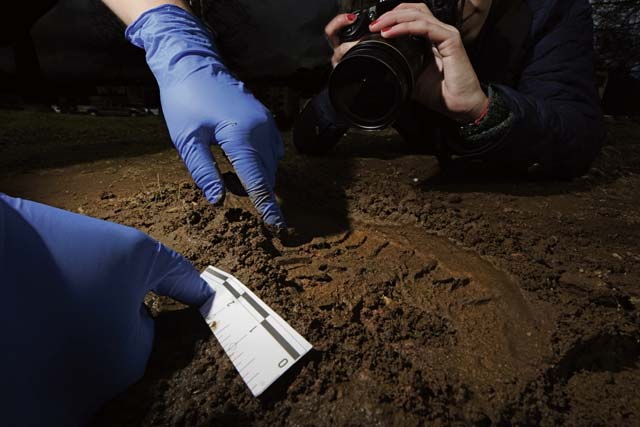
Like a jigsaw puzzle, an investigation can’t be completed without all the pieces in their precise position, so Air Force Office of Special Investigations Airmen work tirelessly searching through jumbled pieces of information, using their skills of detection to fit the puzzle together and help catch criminals.
They are the crime scene investigators of the KMC.
“Sometimes it’s a dangerous and time consuming career,” said Special Agent Sara Moe, U.S. Air Forces in Europe and Air Forces Africa criminal investigator. “We are always on call, and we always have to be ready for anything that comes our way.”
These crime scene investigators undergo an extensive 11-week training program where they conduct physical training several times a week and learn an array of skills, including defensive tactics, emergency driving, evidence processing, firearms, search and seizure, and arrest techniques, all of which they use to hunt criminals.
“Every investigation is different,” said Special Agent Joshua Tree, USAFE-AFAFRICA criminal investigator. “Even if the same crime is committed, none of the cases are predictable, so we have to be prepared to face anything.”
Unlike other U.S. federal agencies, the OSI is not only specialized in a single area. OSI is one of the most diverse law enforcement entities in the United States. Their crime preventing responsibilities range from protective service and counterfeiting to homicide and illegal substance distribution.
They deal with almost all felony level crimes committed by Air Force members, such as murder, sexual assault, drug and human trafficking, as well as cyber crimes.
These crime scene investigators also have a counter intelligence mission and a counter espionage mission, allowing them to stop and prevent any and all criminal activities without
including outside sources.
According to investigators, nothing can be left to chance; overlooking the smallest bit of evidence or disrupting a scene of a crime could be the pivotal point in any case.
“A lot goes into processing a crime scene, and all of it is important,” Tree said. “Missing one little detail or not paying enough attention to all the clues could put someone innocent behind bars or allow the guilty to walk free, so we have to gather all the information and use it effectively to crack the code.”
The agents collect evidence by using many different methods, including DNA, digital images, fingerprints, impressions, video, audio and documents, all of which lead to directly solving cases.
“There’s always something left behind and there’s always a way to find it,” Moe said. “Whether it’s hair follicles, fingerprints or an eye witness, with enough time and motivation we can piece together the puzzle.”
To ensure each scene is documented properly they measure, sketch and photograph the entire area before evidence is identified and collected. During this process, agents must be careful and cognizant of their movements as well as wear protective gear so they don’t contaminate the crime scene by moving items around or destroy DNA evidence.
After evidence is gathered and processed the investigators have to stay resilient for each case, because depending on the severity, they could potentially be working on a single case from anywhere between a few days to a few years.
“It’s a long and stressful process, but there’s nothing like looking the victims in the face and telling them I found the person responsible for their pain,” Moe said.
The work of these criminal investigators may not be as flashy as a TV drama, but it’s still a dangerous game of cat and mouse, truth and lie, mystery and conspiracy, and with every piece added to the puzzle, it grows more confusing and more difficult to find the right fits.
With that on their minds, these crime fighters must never grow weary, because for every waking moment there’s another link leading closer to the completion of the puzzle.
Staff sergeants or senior airmen interested in becoming OSI agents should call 480-5779.


